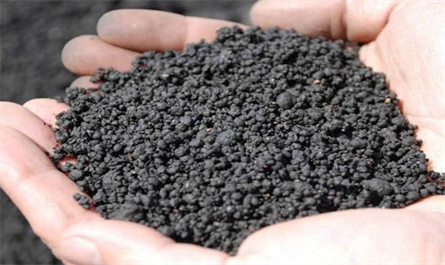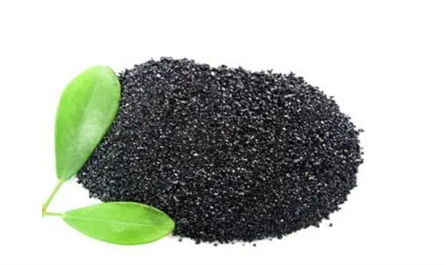Functions of biostimulant Humic Acids
Humic Acids: It is a mixture of various high-molecular organic weak acids formed by the decomposition and transformation of animal and plant residues through microorganisms and a long geophysical and chemical transformation process. It is rich in various active functional groups such as carboxyl, hydroxyl, methoxy, carbonyl, and quinone.
The main elements of Humic Acids are carbon, hydrogen, oxygen, nitrogen, and sulfur. It is a condensation product of polyvalent phenol-type aromatic compounds and nitrogen compounds. It is widely distributed in low-grade coal, soil, water sediments, animal feces, organic fertilizers, animal and plant residues, etc.

The role of Humic Acids:
1). Direct effect: promote plant growth and increase crop yields.
2). Indirect effect
① Physical effect of Humic Acids
★ Improve soil structure;
★ Prevent soil cracking and erosion;
★ Increase soil water holding capacity and improve cold resistance;
★ Darken the soil color, which is conducive to solar energy absorption.

②Humic Acids Chemical Action
★Regulate soil pH value;
★Improve and optimize plant absorption of nutrients and water;
★Increase soil buffering capacity;
★Under alkaline conditions, it is a natural chelating agent (chelates with metal ions to promote their absorption by plants);
★Rich in organic matter and minerals necessary for plant growth;
★Increase the solubility of organic fertilizers and reduce fertilizer loss;
★Convert nutrients into a state that is easily absorbed by plants;
★Can enhance plant absorption of nitrogen, reduce phosphorus fixation, and can protect and store nitrogen, phosphorus, potassium and other elements that penetrate into the soil in the soil, and can accelerate the process of nutrients entering the plant body, improving the application effect of inorganic fertilizers. Therefore, humic acid is a "reserve" of plant nutrients and physiologically active substances.

③Humic Acids Biological Effects
★ Stimulate the growth and reproduction of beneficial microorganisms in the soil;
★ Contains a variety of active functional genes, which can enhance the activity of catalase and polyphenol oxidase in crops, stimulate physiological metabolism, and promote growth and development;
★ Can reduce the opening intensity of plant leaves' stomata, reduce leaf transpiration, thereby reducing water consumption, improving the water status of plants, ensuring the normal growth and development of crops under drought conditions, and enhancing drought resistance;
★ Humic Acids are mostly amphoteric colloids with high surface activity, which have an inhibitory effect on fungi, can enhance the cold resistance of crops, are easily adsorbed by cell membranes, change cell membrane permeability, promote the absorption of inorganic nutrients, prevent rot and root rot, and reduce diseases and insect pests;
★ Humic Acids can form complexes or chelates with trace elements, adjust the ratio and balance of macroelements and trace elements, and strengthen the synthesis and operation of enzymes on sugars, starch, protein, fat and various vitamins. It can promote enzyme activity, convert polysaccharides into soluble monosaccharides, increase the synthesis and accumulation of starch, protein, and fat substances, and accelerate the movement of primary products of various metabolisms from stems, leaves or roots to fruits and seeds, making the fruits plump and thick.
A large number of studies have shown that Humic Acids is a close friend of inorganic fertilizers, a slow-release agent and stabilizer for nitrogen fertilizers, a synergist for phosphorus fertilizers, a protective agent for potassium fertilizers, a regulator and chelating agent for medium and trace elements, and has a significant synergistic effect on chemical fertilizers.
The main elements of Humic Acids are carbon, hydrogen, oxygen, nitrogen, and sulfur. It is a condensation product of polyvalent phenol-type aromatic compounds and nitrogen compounds. It is widely distributed in low-grade coal, soil, water sediments, animal feces, organic fertilizers, animal and plant residues, etc.

The role of Humic Acids:
1). Direct effect: promote plant growth and increase crop yields.
2). Indirect effect
① Physical effect of Humic Acids
★ Improve soil structure;
★ Prevent soil cracking and erosion;
★ Increase soil water holding capacity and improve cold resistance;
★ Darken the soil color, which is conducive to solar energy absorption.

②Humic Acids Chemical Action
★Regulate soil pH value;
★Improve and optimize plant absorption of nutrients and water;
★Increase soil buffering capacity;
★Under alkaline conditions, it is a natural chelating agent (chelates with metal ions to promote their absorption by plants);
★Rich in organic matter and minerals necessary for plant growth;
★Increase the solubility of organic fertilizers and reduce fertilizer loss;
★Convert nutrients into a state that is easily absorbed by plants;
★Can enhance plant absorption of nitrogen, reduce phosphorus fixation, and can protect and store nitrogen, phosphorus, potassium and other elements that penetrate into the soil in the soil, and can accelerate the process of nutrients entering the plant body, improving the application effect of inorganic fertilizers. Therefore, humic acid is a "reserve" of plant nutrients and physiologically active substances.

③Humic Acids Biological Effects
★ Stimulate the growth and reproduction of beneficial microorganisms in the soil;
★ Contains a variety of active functional genes, which can enhance the activity of catalase and polyphenol oxidase in crops, stimulate physiological metabolism, and promote growth and development;
★ Can reduce the opening intensity of plant leaves' stomata, reduce leaf transpiration, thereby reducing water consumption, improving the water status of plants, ensuring the normal growth and development of crops under drought conditions, and enhancing drought resistance;
★ Humic Acids are mostly amphoteric colloids with high surface activity, which have an inhibitory effect on fungi, can enhance the cold resistance of crops, are easily adsorbed by cell membranes, change cell membrane permeability, promote the absorption of inorganic nutrients, prevent rot and root rot, and reduce diseases and insect pests;
★ Humic Acids can form complexes or chelates with trace elements, adjust the ratio and balance of macroelements and trace elements, and strengthen the synthesis and operation of enzymes on sugars, starch, protein, fat and various vitamins. It can promote enzyme activity, convert polysaccharides into soluble monosaccharides, increase the synthesis and accumulation of starch, protein, and fat substances, and accelerate the movement of primary products of various metabolisms from stems, leaves or roots to fruits and seeds, making the fruits plump and thick.
A large number of studies have shown that Humic Acids is a close friend of inorganic fertilizers, a slow-release agent and stabilizer for nitrogen fertilizers, a synergist for phosphorus fertilizers, a protective agent for potassium fertilizers, a regulator and chelating agent for medium and trace elements, and has a significant synergistic effect on chemical fertilizers.
RECENT POSTS
Featured News



